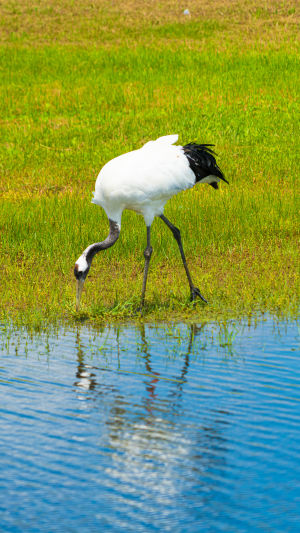The red-crowned crane, also known as the Japanese crane, is a large crane-like bird that is widely considered one of the rarest and endangered birds in the world. It is an endemic species in East Asia, mainly distributed in Northeast China and Korean Peninsula.
Here is some information about red-crowned cranes:
Appearance characteristics: The red-crowned crane is about 1.5 meters tall and is one of the tallest birds in the world. They have light gray plumage with a reddish crown and neck and a prominent black crest. The mouth and feet are black.
Breeding and habitat: Red-crowned cranes like to inhabit open wetland environments such as wetlands, swamps, and river edges. They are monogamous birds, breeding with only one mate throughout their lives. They breed in nesting areas each summer, usually in tall grass or swampy ground.
Migration: The red-crowned crane is a seasonal migratory bird that migrates southward from its breeding grounds every autumn, mainly inhabiting wetland areas in central China, South Korea, and southern Japan for the winter. When spring comes, they return to the breeding grounds to reproduce.
Eating habits: Red-crowned cranes mainly eat plant food, including roots, seeds, insects, and voles of aquatic plants. They use their long, thin bills to forage in water or on the ground.
Conservation Status: The red-crowned crane is under serious threat mainly due to habitat loss and destruction, human disturbance, and illegal hunting. Due to its endangered status, the red-crowned crane is listed as "endangered" on the IUCN Red List of Threatened Species. Governments and conservation organizations around the world are actively taking action to protect red-crowned cranes and their habitats to ensure their survival and reproduction.
Red-crowned cranes are fascinating birds. Their magnificent appearance and unique living habits make them the focus of bird observation and protection. Protecting red-crowned cranes is of great significance to maintaining biodiversity and ecological balance, and conveys important information on protecting the natural environment.
By protecting red-crowned cranes and their habitats, we can maintain the health of wetland ecosystems and promote the reproduction and survival of other species. Red-crowned cranes are also an important resource for ecotourism, attracting many bird watchers and nature lovers.
In order to protect red-crowned cranes, various countries have adopted various measures. This includes establishing protected areas, restricting development activities, enforcing laws and regulations, conducting scientific research, and educating. At the same time, international cooperation has also played an important role, with countries working together to promote the protection and restoration of red-crowned cranes.
It is worth mentioning that red-crowned cranes also play an important role in the field of culture and art. It is often depicted in paintings, traditional cultural works, and literature, symbolizing elegance, purity, and longevity. Red-crowned cranes have a unique symbolic meaning in people's hearts, representing peace, prosperity, and happiness.
The red-crowned crane is a rare and fascinating bird whose survival status is seriously threatened. Protecting red-crowned cranes is our responsibility. It is not only crucial to maintaining ecological balance and biodiversity but also reflects our respect and protection of the natural environment. Through global cooperation and continued efforts, we can ensure that red-crowned cranes and their beautiful habitats are effectively protected, allowing this magnificent bird to flourish for generations to come.





